Who doesn’t love a goldfish? These easy-to-care for, comical, energetic little fish are simply adorable – and pretty much anyone can raise one.
Comet Goldfish are the only species of goldfish that was specifically developed in America. This happened way back in the 1800s, and these colorful little fish have been beloved by millions ever since, partially thanks to their striking looks and energetic personality.
Goldfish are easy to care for, but there definitely some things you need to know if you want to keep a happy, healthy comet goldfish for a long time.
Let’s ask some questions like “How long do comet goldfish live?” “Is my yellow comet goldfish colored normally?” “How big do comet goldfish get?” And ultimately, “What do I need to know about Sarasa comet goldfish care?”
These sparky little guys that often get confused with the others, too, so it’s important to know the difference between Common Goldfish vs Comet Goldfish.
Let’s dive in.
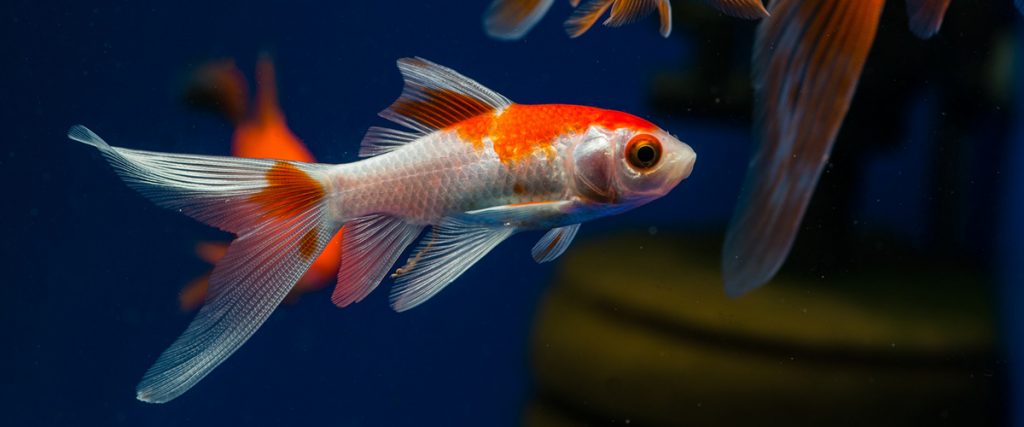
Quick Intro to the Comet Goldfish
| Family | Cyprinidae |
| Scientific Name | Carassius auratus |
| Other Name | Comet-tailed goldfish |
| Care Level | Easy |
Natural Habitat, Identification, and Where to Buy
As mentioned above, Comet Goldfish were developed in the United States in the 1800s. They were first introduced commercially to the aquarium keeping market at that time.
Comet Goldfish get their names from their looks – long, flowing tail fins that folks have compared to the image of a comet burning a trail through the sky. But when you look at Common Goldfish vs Comet Goldfish, you’ll see that though they are very similar, Comets have a longer body and much longer, flowing fins.
Comet goldfish colors are typically reddish orange shades, but they can come in red, yellow, orange, white, or bi-color varieties. The Sarasa Comet specifically is a red and white bi-color variety.
The Comet Goldfish is a single-tailed fish, though that tail is deeply forked, and they’re less stiff – very fluidly moving – than other varieties. The fins are small and smooth and have flat scales without bumped sides.
Comet Goldfish are an especially energetic species of Goldfish, so you’ll see them darting around and swimming loads – which means they have specific aquarium requirements, which we’ll talk about later.
Once you’re ready to buy your Comets, you can shop in person at just about any pet store, or you can shop online for healthy comets at:
Optimal Water Conditions for Comet Goldfish
| Temperature | 60 to 75 degrees Fahrenheit |
| Water Flow Rate | Slow |
| pH | 7.0 to 8.4 |
| Hardness | 6.5 to 7.5 |
| Tannin Recommendations | Tannins aren’t good for goldfish. If you’re planning to use anything like driftwood or other objects that may contain tannins, be sure to properly clean the object and remove the tannins completely to avoid causing health issues for your comets. |
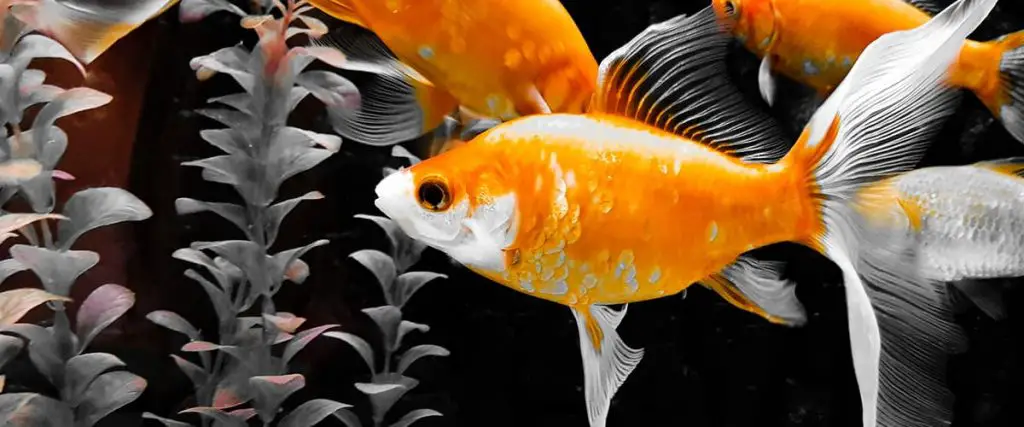
Tank Setup
| Minimum Tank Size | 50-gallon tanks |
| Optimal Tank Size | 75+ gallons |
| Optimal Tank Shape | Long, rectangular |
| Recommended Filter Type | Canister filters are the best for goldfish. These guys need pretty heavy filtration for the healthiest possible home. All three types are best: mechanical, biological, and chemical. |
| Extra Air Flow and How to ProvideThe best way to provide sufficient air flow for Comets is through the use of air stones and a powerful filter pump. Your goldie is naturally built for slow-moving water, however, so it’s important to provide low-flow pumps that still thoroughly aerate the aquarium water. |
There’s this myth out there for goldfish that they won’t grow beyond the capacity of the aquarium or fishbowl that they’re kept in.
This means a lot of people have kept Comet Goldfish tank sizes way too small and thought they were just helping the fish to stay small and cute. But, sadly, they discover too late that their little Comets die quickly.
The myth has been damaging fish – and leading to early deaths for many years.
You see, Comets – like many other easy fish – need enough space to actually grow and thrive. Comet goldfish need much larger tanks than purported – in fact, they need 50-gallons of water to thrive. Better yet, because these guys are so active, they do best with 75+ gallons of water.
They do best in long, rectangular aquariums. These fish are, after all, highly popular because of their active nature. So instead of confining them to weirdly shaped cutesy tanks, they should be given loads of room for movement.
Rectangular aquariums also provide your fish with adequate surface area for that swimming and for proper oxygenation of the water. Goldfish tend to rise to the top of the water and hang out – that classic gaping goldfish face is real.
Though Comets were created in America, their ancestors originally lived in East Asia, in slightly murky, sometimes stagnant bodies of water. This means they need places to hide and take refuge, since they would have this option in the wild.
It should also be noted that goldfish produce an excess amount of waste, so proper filtration and regular cleaning are mandatory for the health of your goldies.
Creating the Landscape
Goldfish need solid filtration systems to remove floating debris, excess food, and help deal with fish waste.
This means not only should you install a high quality goldfish water filter, but you should also provide your goldfish with loads of plants.
Plants not only provide your fish with places to hide and breed (like for Jack Dempsey), but they add additional elements of filtration, provide an additional live food source, and generally improve the quality of life your Comets.
Since goldfish are cold water, freshwater fish, they need plants that do well in cold water environments. Goldfish naturally live in locations like ponds, so plants that come from pond-type settings are important – just don’t dig them up and replant them yourself.
Goldfish also need air stones, as mentioned above, to help improve the quality of life and oxygenation of water in the fish tanks. They also add some entertainment qualities for both you and your fish, which only increases their value.
Always keep a cover on your fish tank. Comets – like many other goldfish – are jumpers, so secure the lid every time you remove it for any reason.
Comets also like to dig around in substrate, so be sure to avoid anything with sharp edges – like crushed corals – to make sure your Comets are kept safe and snag free. They do like gravel, however, not sand, so be sure to use smooth, polished stones, rather than jagged ones.
Best Plants: Java fern, Anubias, Crypts, Amazon Swords, Anacharis, Duckweed, Pothos, Java Moss, Water Sprite, Onion Plant
Best Lighting: Moderate to bright
Best Decorations: Loads of plants, smooth surfaced decorations like rocks and sunken ships. Mid to large sized gravel made of smooth stones.
Decorations to Avoid: Small gravel, sharp decorations and substrate, sand, and driftwood. Goldfish tend to eat sand and tiny gravel, so avoid these altogether, and aim for larger river rocks and mid-size, smooth, polished rocks only for your substrate.
Physiological Considerations
| Maximum Comet Goldfish size | 14-inches |
| Rate of Growth | 3 to 4 years for Comet Goldfish full size |
| Life Span | 5 to 14 years |
| Temperament | Peaceful and Playful, Highly Energetic |
| Preferred Tank Region | Any region |
- Scale Thickness – Goldfish have standard scale thickness, but because they are so active and social, they may have a tendency to lose their scales due to bumping into objects frequently. If you notice your Comet is losing scales, first check for bacterial infections. If there is no bacteria present, look at objects in the aquarium. Remove any that have collected any scales, as these objects are harming your goldfish.
- Gill Considerations – Goldfish use their gills to breathe oxygenated water. Cooler water is more heavily oxygenated than warm water. For their best health, keep the aquarium water on the cooler side of their temperature region.
- Swimbladder Considerations – Goldfish of all species are prone to swim bladder conditions. Comets and others have a tendency to overeat, so it’s important to make sure they are fed appropriately and never given excess food. Swim bladder conditions can be caused by overeating, poor food types, and unclean tank conditions.
- Fin Shape Considerations – Comets have flowing tails and fins. This means they should never be kept with fin nippers and sharp objects that may snag their fins.
Full grown comet goldfish have a long lifespan of up to 14 years. If they live in really well-sized and well-maintained habitats, comets may live even longer and often are confused with Koi at this point in their lives, due to being such large Comet Goldfish.
Comets are incredibly intelligent little fish and can grow to recognize their owners. They’ll know their tank surroundings, fellow tankmates, and anyone or anything else they come into regular contact with.
Because they are also incredibly energetic, social creatures, they tend to get bored – which may convince them to get into mischief. To help avoid this boredom, try switching out some of their decoration items for new ones once or twice a year.
Society
Comet goldfish are extremely social animals. They recognize their owners and fellow aquarium mates and get along well with most other low-key aquarium life. They are especially suited to small to mid-sized non-aggressive fish.
They can get a little aggressive during feeding time – we’ll address this issue below – but otherwise, they’re pretty chill little fish that love to swim and keep active all day.
There are a ton of fish that make great Comet goldfish tank mates, including:
- Zebra Danios – as long as they are kept in schools together with your comets
- Bristlenose Plecos
- Weather Loaches
- Rosy Barbs
- Golden Barbs
- Dojo Loaches
- Common Goldfish
- Shubunkin Goldfish
- Other Comets
- White Cloud Mountain Minnows
- Rubber Nose Plecos
- Apple Snails
- Ghost Shrimp
- Cherry Shrimp
It’s important to never house Comet Goldfish with fancy goldfish such as Oranda, Black Moors, Veiltails, Ryukin, or Telescope Eye Goldfish. They won’t mix well.
You should also avoid stocking Comet aquariums with:
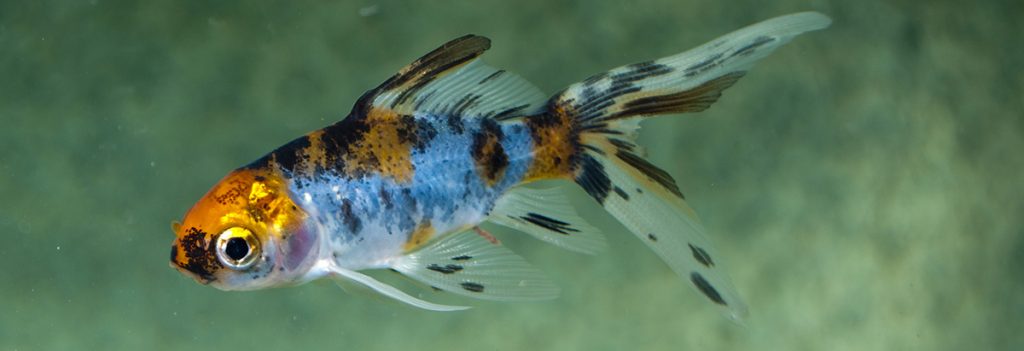
Gender, Breeding, and Reproductive Considerations
At a glance, you won’t immediately be able to tell male Comets from female Comets, unless the female is pregnant. But there are more subtle ways of telling the genders apart.
Specifically, males develop breeding tubercles that look like white pimples. These are on the gill covers and on the leading edges of their pectoral fins. Females develop larger bodies as they grow eggs and have a larger vent than males of their species. These vents are before the anal fin.
The easiest way to sex these fish, however, is to watch their behavior. During mating season, the males give themselves away by chasing the females. The one problem with this, though, is that males will chase other males if there are no females present in your stock. So, watch behaviors and keep an eye out for those tiny changes – like body growth and the vents.
Now, if you want to breed Comets on your own, it is possible, but only if you keep them in a large enough tank. Comets need loads and loads of space in general but toss in the necessity for additional space during breeding season, and you’re looking at a pretty massive aquarium.
It’s also important to note that for Comet Goldfish breeding, you’ll need to make sure there are only Comets in the tank where you’re keeping them – otherwise, they may cross-breed with other Goldfish species.
Goldfish need a trigger for spawning. Since they are cold water fish, the easiest trigger to induce this behavior is a mild temperature increase in the water.
Keep them in cooler temperatures for at least a month before you plan to breed them, then gradually increase the temperatures until they reach around 70 degrees Fahrenheit. This will trick their little brains into thinking it’s spring, and time to reproduce.
You’ll know right away if this has induced breeding – the males will start chasing the females immediately. Then the females will release their eggs in nearby plants, if breeding has been successful.
Nutritional Needs
Like other myths about goldfish, what Comets eat matters. Comet Goldfish food needs to be high-quality, not cheap, whatever’s on sale flake and pellet food. To best understand what Comets need, check out a Goldfish feeding guide where you’ll learn, in great detail, what your Comet should eat.
In a nutshell, though, Comets are omnivores and tend to eat whatever is thrown their way. Because of this, they need a specially curated diet to ensure their optimum health.
In the wild, goldfish eat things like insect larvae, small insects, plant roots, and small crustaceans. These options can be imitated through a variety of choices at home. But the best man-made food for your goldfish is going to be a gel food, rather than flakes or pellets.
Comets are not aggressive generally, though they can be somewhat aggressive during feedings. This is particularly true with other species. Reduce this aggression by feeding at both ends of the fish tank. This reduces the immediate proximity competition for food, which will most likely drop the aggression of your comet.
Best Sustenance Food Type: Gel foods designed for goldfish
Additional Food for Optimal Health: Small insects, worms, bloodworms, mosquito larvae, brine shrimp, ants. Vegetables and fruits, as well, including zucchini, lettuce, cucumbers, broccoli, mashed peas, algae wafers, finely chopped blueberries and strawberries.
Special Foods and Considerations for Best Color and Growth: Larvae, small insects, bloodworms, and worms are your best bet for bringing out their vibrant coloration.
When and How Often to Feed Fish Based on Life Cycle: You should feed your Comet goldfish one or two times daily. They can live without food for several days, however, and often do better without multiple feedings.
They eat the live plants in the aquarium regularly, so it’s better to feed them less than more. Feed them only what they can eat in 1 to 2 minutes’ time.
Common Diseases and How to Avoid and Treat Them
Like all cold water, freshwater fish, Comets are susceptible to some common ailments, including:
- Fin rot
- Goldfish Ich
- Fungal infections
- Swim Bladder conditions
Ich looks like snow drops on your goldfish’s body. This is one of the most common health problems for fish. The best way to treat this nasty bug is by raising the water temperature to the top temperature that Comets can handle and maintaining the water at this temperature consistently for two weeks.
This will power through the life cycle of the Ich at a faster rate and kick it out faster. Maintain water parameters and keep an eye on your fish to make sure this is doing the trick.
Generally speaking, your best bet with any of these conditions is prevention, rather than treatment. Keep your fish tank clean and the water pure. Avoid overfeeding. Regularly check on the appearance of your goldfish.
If you notice any changes, immediately take action to reduce the growth of any infections, bacteria, et cetera. And make sure that your filters are working properly.
Best Antibiotics: Furan 2, Kanaplex, Metroplex, Sulfaplex
Treatments to Avoid: Don’t make water changes too quickly – this common misconception can cause severe stress for your fish and harm his health.
Food Recommendations When Sick: Loads of protein and up the veggie intake with mashed peas and lettuce.
Hospital Tank or Isolation Within the Community Tank Specifics: Be sure to constantly clean equipment like gravel vacuums, et cetera to avoid the spreading of disease.
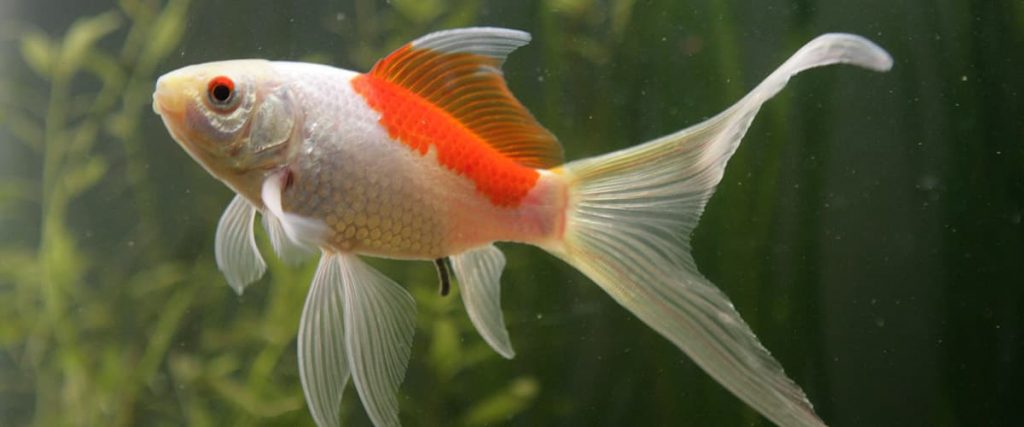
3 More Things to Know About Comet Goldfish
- The Comet Goldfish is the only breed of goldfish that was developed in America.
- Goldfish – most, or all varieties – are the only animals that can see both ultraviolet and infrared light.
- The oldest recorded goldfish was more than 43 years old.
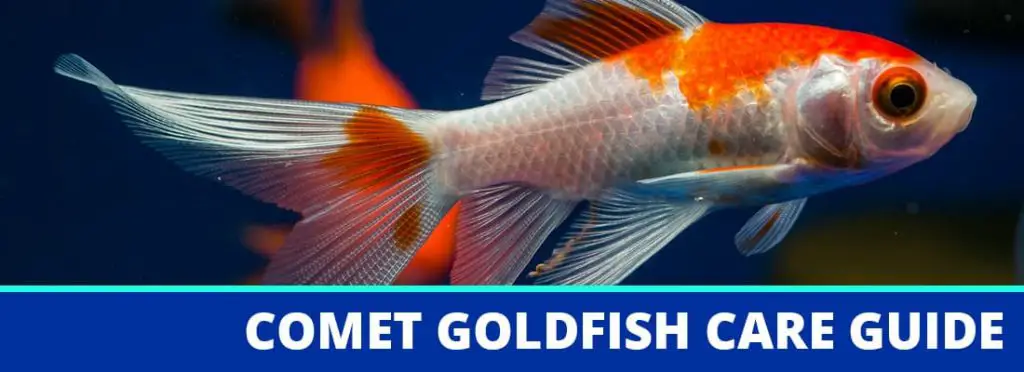
Good day. Thank you for all your valuable input regarding comets. I have a round raised pool (kids swimming) that holds around 8-10,000 liters. Unfortunately as nature will be, I soon discovered my fish were dwindling in numbers because a family of Kingfishers decided that this was easy hunting. I have since put shadenet over the pool but obviously this restricts all visibility to watch these attractive fish. Is there any other alternative as I don’t want to lose anymore to nature’s needs.
Kind regards.